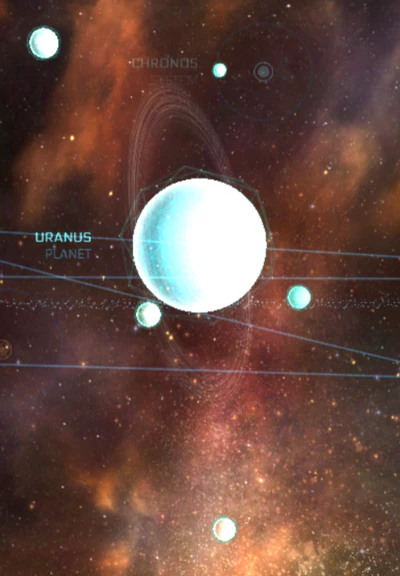 | ||
| Uranus : Sol VII | ||
|---|---|---|
| System | Sol | |
| Type | Planet | |
| Classification | Ice Giant | |
| Habitable | No | |
| Affiliation | United Empire of Earth | |
| Location | UEE space └ Sol system └─ Orbiting Sol (star) | |
| Natural Satellites | 5 | |
| Equatorial Radius | 25,559 km (Real) 2,555.9 km (Ingame Scale) | |
| Gravity | 0.886G | |
| Axial Tilt | 97.77° | |
| Density | 1.27 g/cm³ | |
| Tidally Locked | No | |
| Orbital Period | 30,688.5 SED | |
| Orbital Speed | 6.80 km/s | |
| Orbital Radius | 19.2184 AU (Real) 1.92184 AU (Ingame Scale) | |
| Orbital Eccentricity | 0.046381 | |
| Aphelion | 20.11 AU (Real) 2.011 AU (Ingame Scale) | |
| Perihelion | 18.33 AU (Real) 1.833 AU (Ingame Scale) | |
| Inclination | 1.02° | |
| View on Ark Starmap | ||
Uranus (Sol VII) is an ice giant in Sol System that has an unusual lopsided magnetic field due to a dramatic tilt of its axis that places its north and south poles where most other planets have their equator.[1]
Atmospheric Composition
Uranus' atmosphere is primarily composed of Hydrogen with some Helium.
| Chemical Formula | Full Name | Amount |
|---|---|---|
| H2 | Hydrogen | 83% |
| He | Helium | 15% |
| CH4 | Methane | 2.3% |
| HD | Hydrogen Deuteride | 0.009% |
| H2S | Hydrogen Sulfide | Trace |
| NH3 | Ammonia | Ice Crystals |
| H2O | Water | Ice Crystals |
| NH4SH | Ammonium Hydrosulfide | Ice Crystals |
| 4CH4·23H2O | Methane Hydrate | Ice Crystals |
Natural Satellites
Miranda is one of the smallest objects in the Sol System known to be in hydrostatic equilibrium. Its extreme and varied topography includes the Verona Rupes, which features the tallest cliff in the system.
The surface of this moon is crisscrossed by an extensive network of scarps, canyons and ridges. Scientists speculate some of these canyons were carved out by liquid ammonia, methane or carbon monoxide.
This moon's name has its roots in the Latin word "umbra", which means shadow. An appropriate reference considering Umbriel is the darkest of all Uranian moons.
Titania is Uranus' largest moon. Enormous canyons and scarps cut through its surface. Scientists believe they were created after an interior expansion occurred during the moon's evolution.
Uranus' second largest moon was named after a mythical faery king from a famous 16th century play. Its surface is covered in impact craters and appears red in color due to space weathering.
See also
References
- ↑ Uranus on ARK Starmap. Starmap